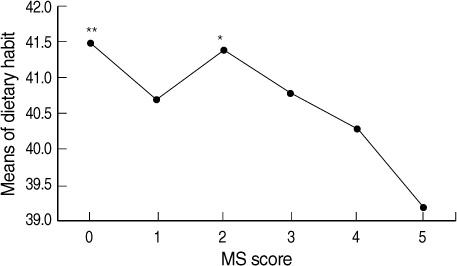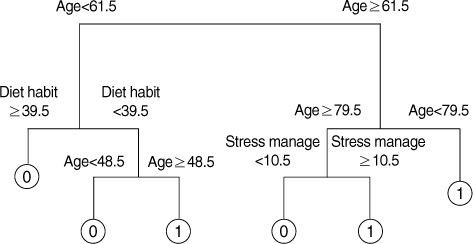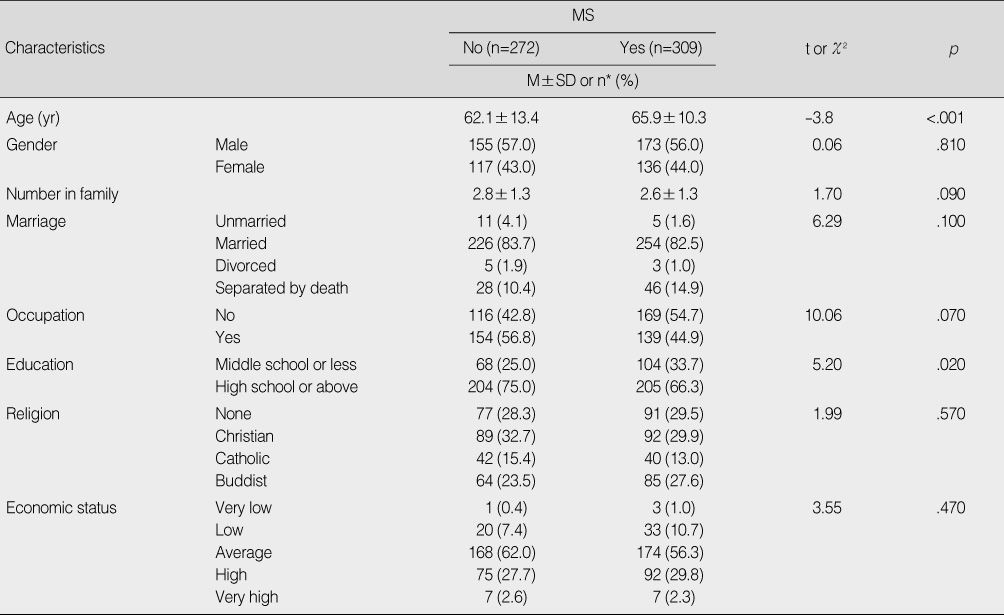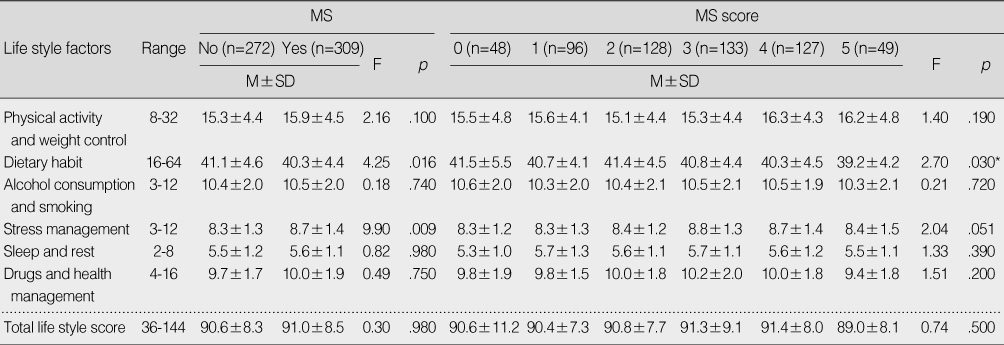Articles
- Page Path
- HOME > J Korean Acad Nurs > Volume 39(4); 2009 > Article
-
Original Article
- Impact of Life Style Characteristics on Prevalence Risk of Metabolic Syndrome
- Ji-Soo Yoo, Jeong In Jeong, Chang Gi Park, Se Won Kang, Jeong-Ah Ahn
-
Journal of Korean Academy of Nursing 2009;39(4):594-601.
DOI: https://doi.org/10.4040/jkan.2009.39.4.594
Published online: August 31, 2009
1Professor, College of Nursing Researcher, Nursing Policy Research Institute, Yonsei University, Seoul, Korea.
2Team Manager, Department of Nursing, Severance Hospital, Seoul, Korea.
3Researcher, University of Illinois at Chicago, IL, USA.
4Post-doctoral Fellow, University of Illinois at Chicago, IL, USA.
5Doctoral Student, College of Nursing, Yonsei University, Seoul, Korea.
- Address reprint requests to: Ahn, Jeong-Ah. College of Nursing, Yonsei University, 262 Seongsan-ro, Seodaemun-gu, Seoul 120-752, Korea. Tel: 82-2-2228-3252, Fax: 82-2-392-5440, narcii@hanmail.net
Copyright © 2009 Korean Society of Nursing Science
Abstract
-
Purpose
- The goal of this study was to evaluate the impact of life style characteristics on the prevalence risk of metabolic syndrome (MS).
-
Methods
- A total of 581 adults were recruited from a cardiovascular outpatient clinic. A newly developed comprehensive life style evaluation tool for MS patients was used, and patient data related to the MS diagnosis were reviewed from the hospital records.
-
Results
- The overall prevalence of MS was 53.2%, and the mean of MS score was 2.6 for patients at a cardiovascular outpatient clinic (78% of the patients had hypertension). Dietary habits among the life style characteristics had significant influence on the prevalence risk of MS and MS scores. And also interestingly, the classification and regression tree (CART) model suggested that the high prevalence risk groups for MS were older adults (61.5≤age<79.4), and adults between 48.5 and 61.5 yr of age with bad dietary habits.
-
Conclusion
- This study indicates that nurses should focus on dietary habits of patients (especially patients classified as high prevalence risk for MS) for improvement and prevention of MS prevalence risk.
- 1. American Heart Association Nutrition Committee. Diet and lifestyle recommendations revision 2006: A scientific statement from the American Heart Association Nutrition Committee. Circulation. 2006;114:82–96.ArticlePubMed
- 2. Azadbakht L, Mirmiran P, Esmaillzadeh A, Azizi T, Azizi F. Beneficial effect of dietary approaches to stop hypertension eating plan on features of the metabolic syndrome. Diabetes Care. 2005;28:2823–2831.PubMed
- 3. Eckel RH, Barouch WW, Ershow AG. Report of the National Heart, Lung, and Blood Institute-National Institute of Diabetes and Digestive and Kidney Diseases Working Group on the pathophysiology of obesity-associated cardiovascular disease. Circulation. 2002;105:2923–2928.ArticlePubMed
- 4. Erdfelder E, Faul F, Buchner A. GPOWER: A general power analysis program. Behavior Research Methods, Instruments, & Computers. 1996;28:1–11.ArticlePDF
- 5. Ford ES. Prevalence of the metabolic syndrome in US populations. Endocrinology and Metabolism Clinics of North America. 2004;33:333–350.ArticlePubMed
- 6. Ford ES, Giles WH, Dietz WH. Prevalence of the metabolic syndrome among US adults: Findings from the third national health and nutrition examination survey. Journal of the American Medical Association. 2002;287:356–359.PubMed
- 7. Giugliano D, Ceriello A, Esposito K. The effects of diet on inflammation: Emphasis on the metabolic syndrome. Journal of the American College of Cardiology. 2006;48:677–685.ArticlePubMed
- 8. Grundy SM, Cleeman JI, Daniels SR, Donato KA, Eckel RH, Franklin BA. Diagnosis and management of the metabolic syndrome: An American Heart Association/National Heart, Lung, and Blood Institute scientific statement. Circulation. 2005;12:2735–2752.
- 9. Gupta R, Deedwania PC, Gupta A, Rastogi S, Panwar RB, Kothari K. Prevalence of metabolic syndrome in an Indian urban population. International Journal of Cardiology. 2004;97:257–261.ArticlePubMed
- 10. Henriksen EJ. Invited review: Effects of acute exercise and exercise training on insulin resistance. Journal of Applied Physiology. 2002;93:788–796.ArticlePubMed
- 11. Hu FB, Li TY, Colditz GA, Willett WC, Manson JE. Television watching and other sedentary behaviors in relation to risk of obesity and type 2 diabetes mellitus in women. Journal of the American Medical Association. 2003;289:1785–1791.ArticlePubMed
- 12. Hu G, Jousilahti P, Borodulin K, Barengo NC, Lakka TA, Nissinen A, et al. Occupational, commuting, leisure-time physical activity in relation to coronary heart disease among middle-aged Finnish men and women. Atherosclerosis. 2007;194:490–497.ArticlePubMed
- 13. Isomaa B, Almgren P, Tuomi T, Forsén B, Lahti K, Nissén M, et al. Cardiovascular morbidity and mortality associated with the metabolic syndrome. Diabetes Care. 2001;24:683–689.ArticlePubMedPDF
- 14. Kahn R, Buse J, Ferranini E, Stern M. The metabolic syndrome: Time for a critical appraisal. Joint statement from the American Diabetes Association and the European Association for the study of Diabetes. Diabetologia. 2005;48:1684–1699.ArticlePubMedPDF
- 15. Kang SW. Development of a lifestyle evaluation tool for patients with metabolic syndrome. 2007;Seoul, Yonsei University. Unpublished doctoral dissertation.
- 16. Kim YH, Yang YO. Effects of walking exercise on metabolic syndrome risk factors and body composition in obese middle school girls. Journal of Korean Academy of Nursing. 2005;35:858–867.ArticlePubMedPDF
- 17. Lee WY, Park JS, Noh SY, Rhee EJ, Kim SW, Zimmet PZ. Prevalence of the metabolic syndrome among 40,698 Korean metropolitan subjects. Diabetes Research and Clinical Practice. 2004;65:143–149.ArticlePubMed
- 18. Miyatake N, Kawasaki Y, Nishikawa H, Takenami S, Numata T. Prevalence of metabolic syndrome in Okayama prefecture, Japan. Internal Medicine. 2006;45:107–108.ArticlePubMed
- 19. National Institute of Health. Executive summary of the third report of the National Cholesterol Education Program (NCEP): Expert panel on detection, evaluation and treatment of high blood cholesterol in adults (Adult treatment panel III). Journal of the American Medical Association. 2001;285:2486–2497.ArticlePubMed
- 20. Oh EG, Bang SY, Hyun SS, Chu SH, Jeon JY, Kang MS. Knowledge, perception and health behavior about metabolic syndrome for an at risk group in an rural community area. Journal of Korean Academy of Nursing. 2007;37:790–800.PubMed
- 21. Ohta Y, Tsuchihashi T, Ueno M, Kajioka T, Onaka U, Tominaga M, et al. Relationship between the awareness of salt restriction and the actual salt intake in hypertensive patients. Hypertension Research. 2004;27:243–246.ArticlePubMed
- 22. Reaven GM. Banting lecture: Role of insulin resistance in human disease. Diabetes. 1988;37:1595–1607.ArticlePubMed
- 23. Riccardi G, Rivellese AA. Dietary treatment of the metabolic syndrome-The optimal diet. British Journal of Nutrition. 2000;83:S143–S148.ArticlePubMed
- 24. Saito I, Murata K, Hirose H, Tsujioka M, Kawabe H. Relation between blood pressure control, body mass index, and intensity of medical treatment. Hypertension Research. 2003;26:711–715.ArticlePubMed
- 25. Tak YR, An JY, Kim YA, Woo HY. The effects of a physical activity-behavior modification combined intervention (PABM-intervention) on metabolic risk factors in overweight and obese elementary school children. Journal of Korean Academy of Nursing. 2007;37:902–913.ArticlePubMedPDF
- 26. Uzu T, Kimura G, Yamauchi A, Kanasaki M, Isshiki K, Araki S, et al. Enhanced sodium sensitivity and disturbed circadian rhythm of blood pressure in essential hypertension. Journal of Hypertension. 2006;24:1627–1632.ArticlePubMed
- 27. Wirfält E, Hedblad B, Gullberg B, Mattisson I, Andrén C, Rosander U, et al. Food patterns and components of the metabolic syndrome in men and women: A cross-sectional study within the Malmo diet and cancer cohort. American Journal of Epidemiology. 2001;154:1150–1159.ArticlePubMed
REFERENCES



Figure & Data
REFERENCES
Citations

- Nomogram for screening the risk of developing metabolic syndrome using naïve Bayesian classifier
Minseok Shin, Jeayoung Lee
Communications for Statistical Applications and Methods.2023; 30(1): 21. CrossRef - Building a Nomogram for Metabolic Syndrome Using Logistic Regression with a Complex Sample—A Study with 39,991,680 Cases
Min-Seok Shin, Jea-Young Lee
Healthcare.2022; 10(2): 372. CrossRef - Association between Clustering of Lifestyle and Chronic Disease Using Healthcare Big Data
Eul Hee Roh, Sang Chan Park
Journal of Health Informatics and Statistics.2020; 45(2): 113. CrossRef - The Effect of Stress on Prevalence Risk of Metabolic Syndrome among Korean Adults
Mee Young Im
STRESS.2019; 27(4): 441. CrossRef - Field Application and Evaluation of Health Status Assessment Tool based on Dietary Patterns for Middle-Aged Women
Hye-Jin Lee, Kyung-Hea Lee
Korean Journal of Community Nutrition.2018; 23(4): 277. CrossRef - Moderating effect of Lifestyle and Type D personality on the Relationship between Metabolic Syndrome and Severity of Coronary Artery Disease
In-Kyoung Noh, Myoung Soo Kim
Korean Journal of Adult Nursing.2018; 30(3): 290. CrossRef - Metabolic Syndrome Status of Chinese Workers and Their Physical Profiles, Lifestyle Scores, and Nutrient Intakes
Chao Wang, Hokyung Ryu
Korean Journal of Community Nutrition.2017; 22(1): 63. CrossRef - Introduction and effectiveness of The Seoul Metabolic Syndrome Management
MiSuk Park, YunSuk Park, SunYoung Kim, Sujin Park, HyeMin Seol, Sunok Woo, Sookyoung Cho, Do-sun Lim
Public Health Affairs.2017; 1(1): 25. CrossRef - Development healthcare PC and multimedia software for improvement of health status and exercise habits
Sekyoung Youm, Shuai Liu
Multimedia Tools and Applications.2017; 76(17): 17751. CrossRef - Influence of Occupational Type and Lifestyle Risk Factors on Prevalence of Metabolic Syndrome among Male Workers: A Retrospective Cohort Study
So Hui Kang, Seon Young Hwang
Korean Journal of Adult Nursing.2016; 28(2): 180. CrossRef - Vitamin D deficiency and Metabolic Syndrome among Korean Adolescents: Based on Korea National Health and Nutrition Examination Survey V (KNHANES)
Ha Na Yoo, Hyeon Suk Kim
Journal of the Korean Society of School Health.2016; 29(1): 22. CrossRef - Factors affecting metabolic syndrome by lifestyle
Nam-Kyun Ki, Hae-Kag Lee, Jae-Hwan Cho, Seon-Chil Kim, Nak-Sang Kim
Journal of Physical Therapy Science.2016; 28(1): 38. CrossRef - A Study on Risk Factors of Metabolic Syndrome and Health Behaviors in a Region - 2014 community health survey -
Ok-hee Ahn, Seong-hui Choi, Seo-Hyeon Kim, Si-Ok Ryu, Young-Mi Choi
Journal of the Korea Academia-Industrial cooperation Society.2016; 17(12): 218. CrossRef - Factors Influencing Metabolic Syndrome among Mental Health Facility Patients with Schizophrenia
Sun-Hye Lee, Sunhee Cho
Journal of Korean Academy of Psychiatric and Mental Health Nursing.2016; 25(1): 1. CrossRef - The Relationship between Metabolic Syndrome Risk Factors and Health Promotion Behavior in General Hospital Nurses
Hyun-Hee Park, Kwang-Ok Lee
The Journal of the Korea Contents Association.2015; 15(6): 314. CrossRef - Metabolic Syndrome Prevalence and Lifestyle by Age and Metabolic Syndrome Status in Women Religious
Yang-Hee Kim, Hee-Seung Kim
Journal of Korean Biological Nursing Science.2015; 17(1): 11. CrossRef - Development and Evaluation of a Mobile Application for Personal Lifestyle Check-Up and Improvement
Sekyoung Youm, Seung-Hun Park
Telemedicine and e-Health.2014; 20(11): 1057. CrossRef - Modeling of Metabolic Syndrome Using Bayesian Network
Mi-Hyun Jin, Hyun-Ji Kim, Jea-Young Lee
Korean Journal of Applied Statistics.2014; 27(5): 705. CrossRef - Development and Application of a Web-Based Nutritional Management Program to Improve Dietary Behaviors for the Prevention of Metabolic Syndrome
YOON CHOI, MIN JUNE LEE, HEE CHEOL KANG, MEE SOOK LEE, SUN YOON
CIN: Computers, Informatics, Nursing.2014; 32(5): 232. CrossRef - Comparison of the Metabolic Syndrome Risk Factors, Physical Activity, and Diet Habits between the Fifties and Sixties in Postmenopausal Women
Hee-Seung Kim, Hye-Ryoung Kim
Journal of Korean Biological Nursing Science.2013; 15(3): 133. CrossRef - Associations between the Practice of Health Behaviors and Awareness of Metabolic Syndrome among Adults (19-64 years) in the Gwangju-Jeonnam Area: 2010 Community Health Survey
In Ae Chun, So Yeon Ryu, Hyeon Hui Park, Jong Park, Mi Ah Han, Seong Woo Choi
Journal of agricultural medicine and community health.2013; 38(4): 217. CrossRef - The study on risk factors for diagnosis of metabolic syndrome and odds ratio using multifactor dimensionality reduction method
Mi-Hyun Jin, Jea-Young Lee
Journal of the Korean Data and Information Science Society.2013; 24(4): 867. CrossRef - The Relationship Between Resting Heart Rate and Risk Factors of Metabolic Syndrome in Korean Adults
Choae Lee, Junga Lee, Justin Y. Jeon
The Korean Journal of Obesity.2013; 22(4): 222. CrossRef - Prevalence and risk factors of metabolic syndrome in the Korean population – Korean National Health Insurance Corporation Survey 2008
Eun Shil Lim, Yu Kyung Ko, Keum Ok Ban
Journal of Advanced Nursing.2013; 69(7): 1549. CrossRef - The Prevalence of Metabolic Syndrome and Related Risk Factors Based on the KNHANES V 2010
Eunok Park, Su Jung Choi, Hyo Young Lee
Journal of agricultural medicine and community health.2013; 38(1): 1. CrossRef - Relation of Health Promotion Behaviors and Metabolic Syndrome in Daytime Workers
Dae-Sik Ko, Bu-Yeon Park, Gyeong-Hyu Seok
The Journal of the Korea institute of electronic communication sciences.2013; 8(12): 1941. CrossRef - The Effects of Lifestyle Factors on Metabolic Syndrome among Korean Adults
Mee Young Im, Young-Ran Lee, Suk Jung Han, Chung-Min Cho
Journal of Korean Academy of Community Health Nursing.2012; 23(1): 13. CrossRef - A Study on Health Behaviors by a Risk Level of Metabolic Syndrome among Petty Merchants in Traditional Markets
Hee-Gerl Kim, Hye-Kyung Nam, Yun-Jeong Yi
Korean Journal of Occupational Health Nursing.2011; 20(3): 328. CrossRef - Comparison of Cardiovascular Health Status and Health Behaviors in Korean Women based on Household Income
Young-Joo Park, Nah-Mee Shin, Ji-Won Yoon, Jiwon Choi, Sook-Ja Lee
Journal of Korean Academy of Nursing.2010; 40(6): 831. CrossRef


Figure 1
Figure 2
Comparison of Demographic Characteristics between the Patients with and without Metabolic Syndrome
*No response excluded. MS=metabolic syndrome.
Comparison of Life Style Mean Scores among the Patient Groups with or without Metabolic Syndrome, and Metabolic Syndrome Scores
*p<.05. MS=Metabolic syndrome.
Odds Ratios of Binary and Ordinal Logistic Regression Model of Metabolic Syndrome
*p<.05; **p<.01.
MS=metabolic syndrome; OR=odds ratio; CI=confidence interval.
*No response excluded. MS=metabolic syndrome.
*
* MS=metabolic syndrome; OR=odds ratio; CI=confidence interval.
 KSNS
KSNS
 E-SUBMISSION
E-SUBMISSION


 Cite
Cite

